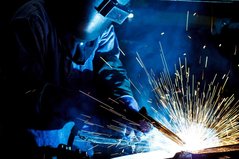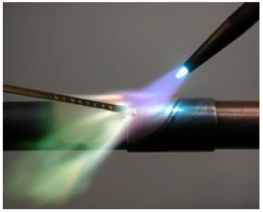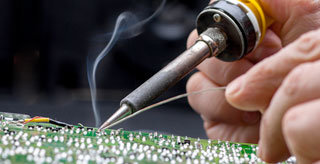Soldering, brazing, and welding are types of metal joining operations. Their application is to join and fill gaps between metal parts. Each of these joining processes has significance, and they are different in terms of base material, joining temperature, and filler material. This article covers the difference between soldering brazing and the welding process.
To understand the difference between welding vs brazing vs soldering, let’s first understand each of these processes in detail.
Welding
The welding process joins two or more similar metals by melting base material or using filler material. Various types of welding techniques to join metal parts are available.

Properties of Welding
Base Material
Experts recommend welding on similar material parts. But special welding techniques to join dissimilar materials are also available. For example, aluminum and steel material welding requires a highly skilled welder because the aluminum melting temperature is less than steel.
Weld Strength
Welded joint strength is similar to the base material strength.
Welded Part Finish
We can use post-processing finish operations to achieve a good surface finish in the welded area.
Welding Temperature
Welding temperature is always higher than base material melting temperature and depends on welding type. For example, arc welding temperature is 5000 to 6000°C, whereas projection or spot welding temperature is 2500 °C.
Brazing
Brazing is a metal joining process where filler road is melted and filled into the joint. The advantage of brazing is to join similar or dissimilar metals with considerable strength.

Properties of Brazing
Base Material
Brazing of dissimilar base materials is possible. For example, you can join aluminum with steel sheets using a brazing metal joining operation.
Joint Strength
Brazing joint strength can be higher than base parts. But they are not as strong as welded joints.
Brazing Temperature
The brazing operation utilizes a filler metal rod to join base materials. Its melting temperature is less than the base metal melting temperature. Generally, the brazing temperature is around 450°C.
Filler Material
Brazing requires brazing flux and filler rod to join parts.
Soldering
The soldering process is similar to brazing. But it is done at a relatively lower temperature. It has applications to join electronics components and materials such as gold, silver, copper, and brass.

Properties of Soldering
Base Material
Different base materials can be soldered. For example, we can solder copper wires with aluminum components.
Joint Strength
Soldered joints have lower strength. Therefore it is used to make electrical connections where high strength is not required.
Temperature
Soldering is done at relatively low temperatures around 300°C to 370°C.
Solder Joint Strength
Soldering joints are not as strong as brazed or welding joints. Therefore it is only used to join electrical components to achieve electrical connection.
Filler Material
It requires soldering flux and filler rods to solder parts.
Soldering vs Brazing vs Welding

| Parameter | Welding | Brazing | Soldering |
|---|---|---|---|
| Base Material | Similar and dissimilar material ( using special welding technique) . | Similar or Dissimilar Materials | |
| Power Required | High | Moderate | Low |
| Process Temperature | ~3400°C | ~450°C | ~300°C to 370°C |
| Joint Strength | Strongest joint | High | Low (Used for electrical connections) |
| Filler Material | may or may not required | Required | |
Frequently Asked Questions: FAQ
A brazing joint is a strong joint. But it is not as strong as welding because both materials fuse during welding.
Brazing joint is stronger than soldering. Soldering joints have an application to create electrical connections only.
Brazing has the advantage of low power consumption, low temperature, and moderate weld strength compared to welding.
To sum up, soldering has applications to join electronics parts to make electrical connections. And we can use brazing to join dissimilar metals using a filler rod, whereas welding joins similar metals at very high temperatures.
We will keep updating this article on soldering vs brazing vs welding. Please add your comments, suggestions, or questions to the difference between soldering brazing and welding. We suggest you also read this article on lean manufacturing.

Add a Comment